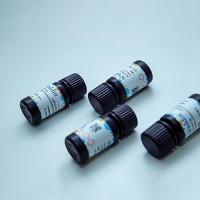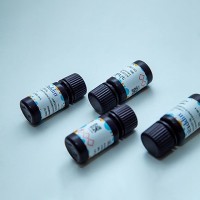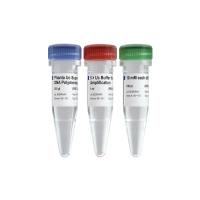cDNA Library Construction from Single Cells
互联网
- Abstract
- Table of Contents
- Materials
- Figures
- Literature Cited
Abstract
cDNA Library Construction from Single Cells (Phillip R. Kramer, National Institute of Neuronal Disorders and Stroke, NIH, Bethesda, Maryland). Analysis of gene expression or comparing gene expression patterns between cells and/or tissues facilitates the identification of molecules activated by a cellular program or by a particular physiological or pharmacological treatment. This unit presents a protocol for studying these molecules at the level of a single cell.
Table of Contents
- Basic Protocol 1: Production and Amplification of cDNA from Single Cells
- Support Protocol 1: Isolation of Individual Cells from Acute Tissue and Tissue Explants Grown in Vitro
- Basic Protocol 2: Phage Library Construction and Differential Screening
- Support Protocol 2: Gene Expression Profiling Using PCR Amplification of Truncated cDNA Libraries
- Reagents and Solutions
- Commentary
- Figures
Materials
Basic Protocol 1: Production and Amplification of cDNA from Single Cells
Materials
Support Protocol 1: Isolation of Individual Cells from Acute Tissue and Tissue Explants Grown in Vitro
Materials
Basic Protocol 2: Phage Library Construction and Differential Screening
Materials
Support Protocol 2: Gene Expression Profiling Using PCR Amplification of Truncated cDNA Libraries
Materials
|
Figures
-
Figure 4.27.1 Flowchart for producing cDNA libraries from individual cells using the protocols provided in this unit. View Image -
Figure 4.27.2 Flowchart of phage library screening protocol. Duplicate lifts are differentially screened with a probe from the same cell (cell A) and a different cell (cell B) from which the library was produced. View Image -
Figure 4.27.3 Single cells in olfactory explants express LHRH mRNA (Kramer et al., ). (A ) Lane 1: a 360‐bp Bam HI‐ Eco RI (1 ng) fragment from the rat LHRH gene. Lane 2: PCR‐amplified cDNA from a control that contained no cells. Lanes 3 to 9: single bipolar cells maintained in unilateral olfactory explants for 10.5 days. The cDNA smear extends from ∼200 to 1000 bp. The band below 200 bp is the AL1 primer band (arrow). (B ) Southern analysis of the PCR‐amplified cDNA using an LHRH‐specific probe indicates the positive control (lane 1) as well as 4 of 7 individual primary cells positive for LHRH (lanes 4, 7, 8, and 9, 360‐bp and 500‐bp bands). The different band sizes are expected due to a truncated reverse transcription reaction. View Image
Videos
Literature Cited
| Literature Cited | |
| Becker, I., Becker, K.F., Rohrl, M.H., Minkus, G., Schutze, K., and Hofler, H. 1996. Single‐cell mutation analysis of tumors from stained histologic slides. Lab. Invest. 75:801‐807. | |
| Brady, G., Barbara, M., and Iscove, N. 1990. Representative in vitro cDNA amplification from individual hemopoietic cells and colonies. Methods Mol. Cell. Biol. 2:17‐25. | |
| Brunet, J.F., Shapiro, E., Foster, S.A., Kandel, E.R., and Iino, Y. 1991 Identification of a peptide specific for Aplysia sensory neurons by PCR‐based differential screening. Science 252:856‐859. | |
| Cheetham, J.E., Coleman, P.D., and Chow, N. 1997. Isolation of single immunohistochemically identified whole neuronal cell bodies from post‐mortem human brain for simultaneous analysis of multiple gene expression. J. Neurosci. Methods 77:43‐48. | |
| Crino, P.B. and Eberwine, J. 1996a. Molecular characterization of the dendritic growth cone: Regulated mRNA transport and local protein synthesis. Neuron 17:1173‐1187. | |
| Crino, P.B., Trojanowski, J.Q., Dichter, M..A., and Eberwine, J. 1996b. Embryonic neuronal markers in tuberous sclerosis: Single‐cell molecular pathology. Proc. Natl. Acad. Sci. U.S.A. 93:14152‐14157. | |
| Davis, L.G., Kuehl, W.M., and Battey, J. 1994. Preparation and analysis of RNA from eukaryotic cells. In Basic Methods in Molecular Biology (S. Greenfield and M. Wonsiewicz, eds.) pp.320‐321. Appleton Lange, East Norwalk, Conn. | |
| Dulac, C. and Axel, R. 1995. A novel family of genes encoding putative pheromone receptors in mammals. Cell 83:195‐206. | |
| Eberwine, J., Cao, Y., Nair, S., Miyashiro, K., Mackler, S., Finnell, R., Surmeier, J., and Dichter, M. 1995. Mechanisms of neuronal plasticity as analyzed at the single cell level. Prog. Brain Res. 105:117‐126. | |
| Fend, F., Emmert‐Buck, M.R., Chuaqui, R., Cole, K., Lee, J., Liotta, L.A., and Raffeld, M. 1999. Immuno‐LCM: Laser capture microdissection of immunostained frozen sections for mRNA analysis. Am. J. Pathol. 154:61‐66. | |
| Fueshko, S. and Wray, S. 1994. LHRH cells migrate on peripherin fibers in embryonic olfactory explant cultures: An in vitro model for neurophilic neuronal migration. Dev. Biol. 166:331‐348. | |
| Hoon, M.A., Adler, E., Lindemeier, J., Battey, J.F., Ryba, N.J., and Zuker, C.S. 1999. Putative mammalian taste receptors: A class of taste‐specific GPCRs with distinct topographic selectivity. Cell 96:541‐551. | |
| Kramer, P.R., Krishnamurthy, R., Mitchell, P.J., and Wray, S. 2000. Transcription factor activator protein‐2 is required for continued luteinizing hormone‐releasing hormone expression in the forebrain of developing mice. Endocrinology 141:1823‐1838. | |
| Li, H.H., Gyllensten, U.B., Cui, X.F., Saiki, R.K., Erlich, H.A., and Arnheim, N. 1988. Amplification and analysis of DNA sequences in single human sperm and diploid cells. Nature 335:414‐417. | |
| O'Dell, D.M., Raghupathi, R., Crino, P.B., Morrison, B., Eberwine, J.H., and McIntosh, T.K. 1998. Amplification of mRNAs from single, fixed, TUNEL‐positive cells. Biotechniques 25:566‐568, 570. | |
| Rappolee, D.A., Wang, A., Mark, D., and Werb, Z. 1989. Novel method for studying mRNA phenotypes in single or small numbers of cells. J. Cell Biochem. 39:1‐11. | |
| Skynner, M.J., Sim, J.A., and Herbison, A.E. 1999. Detection of estrogen receptor alpha and beta messenger ribonucleic acids in adult gonadotropin‐releasing hormone neurons. Endocrinology 140:5195‐5201. | |
| Williams, J.G. 1981. The preparation and screening of a cDNA clone bank. In Genetic Engineering (R. Williamson, ed.) pp. 1‐59. Academic Press, New York. | |
| Key Reference | |
| Dulac and Axel 1995. See above. | |
| The single cell amplification protocol was based on methods outlined in this report. |







